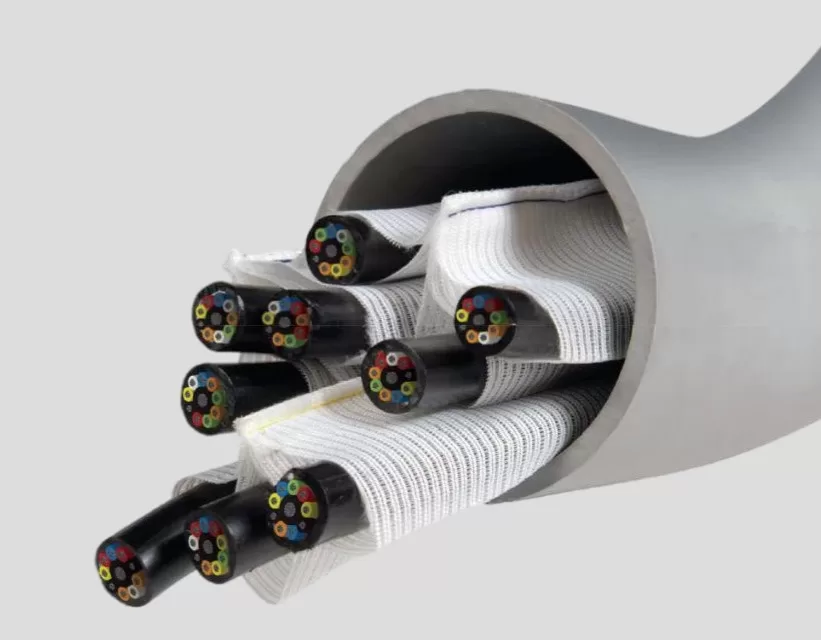
What is 2 Inch 3 Cell Fabric Innerduct?
2 inch 3 cell fabric innerduct is a type of conduit that is made from a flexible fabric material. It is typically used in telecommunications and data center applications to protect and organize cables. Fabric innerduct is designed to be lightweight and easy to install, and it offers a number of advantages over traditional PVC conduit, including:
- Flexibility: Fabric innerduct is much more flexible than PVC conduit, making it easier to install in tight spaces and around corners.
- Durability: Fabric innerduct is also more durable than PVC conduit, and it is resistant to cracking and corrosion.
- Ease of installation: Fabric innerduct can be installed using a variety of methods, including pulling, blowing, and reeling.
- Cost-effectiveness: Fabric innerduct is often more cost-effective than PVC conduit, especially for large-scale projects.
Benefits of 2 Inch 3 Cell Fabric Innerduct
2 inch 3 cell fabric innerduct offers a number of benefits, including:
- Protection: Fabric innerduct protects cables from damage caused by abrasion, crushing, and moisture.
- Organization: Fabric innerduct helps to organize and manage cables, making them easier to access and maintain.
- Flexibility: Fabric innerduct is very flexible, making it easy to install in tight spaces and around corners.
- ความทนทาน: Fabric innerduct is durable and resistant to cracking and corrosion.
- Ease of installation: Fabric innerduct can be installed using a variety of methods, including pulling, blowing, and reeling.
- Cost-effectiveness: Fabric innerduct is often more cost-effective than PVC conduit, especially for large-scale projects.
Applications of 2 Inch 3 Cell Fabric Innerduct
2 inch 3 cell fabric innerduct is commonly used in a variety of applications, including:
- Telecommunications: Fabric innerduct is used in telecommunications applications to protect and organize fiber optic and copper cables.
- Data centers: Fabric innerduct is used in data centers to protect and organize power cables, network cables, and other critical infrastructure.
- Other applications: Fabric innerduct can also be used in a variety of other applications, such as industrial automation, medical facilities, and commercial buildings.
How to Choose the Right 2 Inch 3 Cell Fabric Innerduct
When choosing 2 inch 3 cell fabric innerduct, there are a number of factors to consider, including:
- Cable size and type: The size and type of cables that will be installed in the innerduct will determine the minimum cell size and innerduct diameter required.
- Installation environment: The installation environment will also affect the choice of innerduct. For example, if the innerduct will be installed in a wet environment, it is important to choose a waterproof innerduct.
- Cost: Fabric innerduct is available in a variety of price points. It is important to choose an innerduct that fits within your budget and meets your specific needs.
Installation of 2 Inch 3 Cell Fabric Innerduct
2 inch 3 cell fabric innerduct can be installed using a variety of methods, including:
- Pulling: Pulling is the most common method of installing fabric innerduct. To pull fabric innerduct, a pulling rope is threaded through the innerduct and then attached to a pulling machine. The pulling machine is then used to pull the innerduct into place.
- Blowing: Blowing is another common method of installing fabric innerduct. To blow fabric innerduct, a compressor is used to blow air through the innerduct. The air pressure pushes the innerduct into place.
- Reeling: Reeling is a method of installing fabric innerduct that is used for long distances. To reel fabric innerduct, the innerduct is wound onto a reel and then unwound as it is installed.
Maintenance of 2 Inch 3 Cell Fabric Innerduct
Fabric innerduct is a low-maintenance product. However, there are a few things that can be done to extend the life of the innerduct, including:
- Inspecting the innerduct regularly: It is important to inspect the innerduct regularly for signs of damage. If any damage is found, the innerduct should be repaired or replaced immediately.
- Cleaning the innerduct: The innerduct should be cleaned regularly to remove dirt and debris. This can be done using a vacuum cleaner or a mild soap and water solution.
- Protecting the innerduct from rodents: Rodents can damage fabric innerduct. To protect the innerduct from rodents, it is important to seal any openings in the innerduct and to use rodent traps if necessary.
บทสรุป
2 inch 3 cell fabric innerduct is a versatile and durable conduit that offers a number of advantages over traditional PVC conduit.
